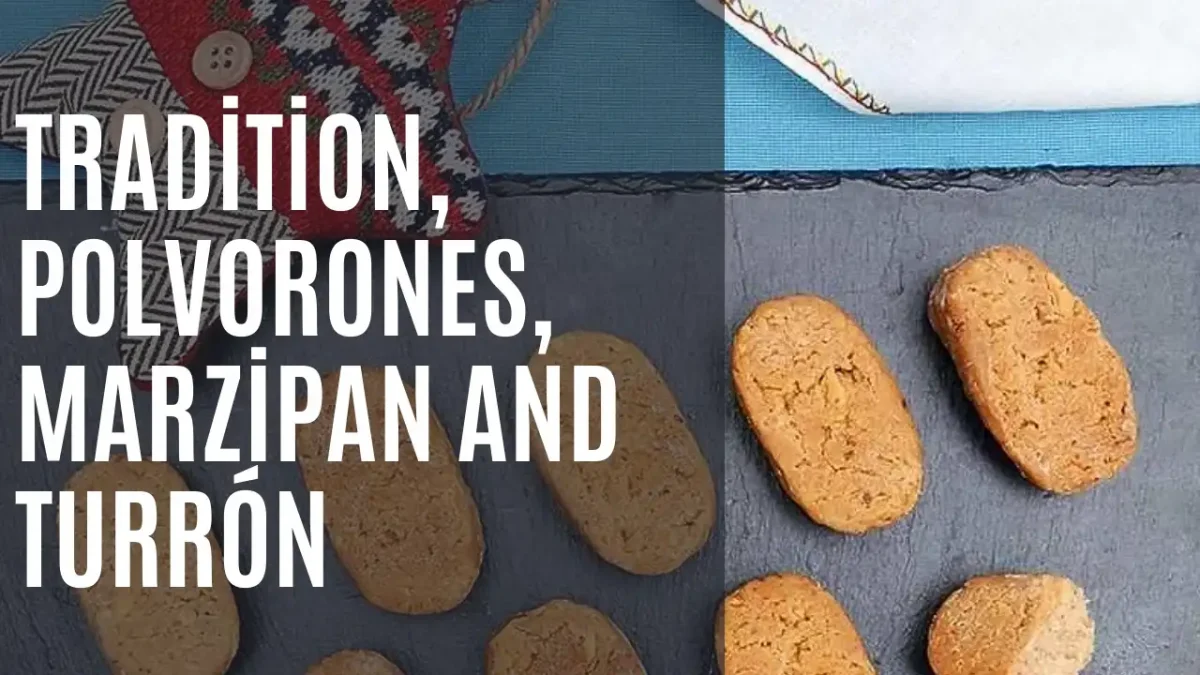The tradition of consuming polvorones, marzipan, and turrón during Christmas in Spain is deeply rooted in the country’s history and culture. Although each sweet has its own unique origin, they all share a strong connection to the celebration of the holiday season. Here’s a closer look at the background and legends behind each of these traditional treats.
1. Turrón: The Tradition of Spanish Nougat
The story of turrón dates back to the time of Muslim rule in Spain, around the 11th century. During that period, the Moors brought with them a mixture of almonds, honey, and sugar—an early version of what we now know as turrón.
Legend of Turrón:
A popular legend says that the Arabs introduced turrón to the Iberian Peninsula as a way to preserve almonds during long journeys. In the Middle Ages, people began making a recipe that combined almonds with honey and sugar, creating a nutritious sweet often used in celebrations. In some regions of Spain, especially in the Valencian Community, it is believed that Jijona turrón (soft nougat) and Alicante turrón (hard nougat) were created by Muslims as a festive gift for Christians during Christmas.
Over time, turrón evolved to suit the tastes and customs of different Spanish regions. Today, it has become a symbol of Christmas, and its consumption during the holidays is associated with generosity and family sharing.
The best-selling nougat in our online store is: Delaviuda Cream and Walnut Turrón
2. Polvorones: The Tradition of Flour, Lard, and Sugar
Polvorones have a more modern origin but remain strongly tied to Spanish traditions. Their name comes from the Spanish word “polvo” (powder), because when eaten, they crumble into a soft, powdery texture that is both unique and light.
Legend of Polvorones:
The origin of polvorones is traced back to Andalusia in the 16th century. It is said that monks in Andalusian convents were the first to make these sweets using a simple mixture of flour, pork lard, and sugar. In their earliest forms, polvorones were not specifically linked to Christmas—they were traditional treats enjoyed year-round.
However, over time, polvorones became increasingly associated with Christmas celebrations. According to one legend, these sweets gained popularity among modest households during the holidays due to their simplicity and low cost. The custom of serving polvorones on the Christmas table became widespread and remains a cherished tradition to this day. They also symbolize generosity, as they are commonly shared during holiday meals and festive gatherings.
The tradition of consuming polvorones, marzipan, and turrón, therefore, the best-selling polvorón in our online store is: 1880 Polvorones
3. Marzipan: The Medieval Sweet
Marzipan has a very ancient history, and its origin is somewhat debated. However, it is clear that it has strong roots in Moorish culinary traditions.
Legend of Marzipan:
The most famous legend about marzipan’s origin is set in Toledo, a city renowned for its marzipan production. According to the story, during the Siege of Toledo in 1085, when King Alfonso VI conquered the city, its citizens were left without food due to the blockade. They created marzipan using the few ingredients they had: almonds, sugar, and water. This sweet, full of nutrients and energy, helped them survive, and over time it became a symbol of the city.
Another version of the legend claims that marzipan was introduced by the Arabs, who spread it across the Iberian Peninsula. Regardless, Toledo remains the heart of Spain’s marzipan tradition, where it is shaped into small figures—often fruits or religious symbols—and is an essential part of Christmas celebrations.
Today, marzipan is mainly enjoyed during the Christmas season. It’s common to find beautifully crafted marzipan figures in shops, ranging from fruits and animals to religious icons like the Three Wise Men.
The best-selling marzipan in our online store is: Soto Marzipan
A Beautiful tradition of consuming polvorones, marzipan, and turrón
In general, the reason these sweets are so closely tied to Christmas celebrations has to do with sharing and abundance. During Christmas, Spanish families gather to share a special meal, and these traditional sweets are an essential part of that joyful moment. They not only symbolize the joy of the season but also the generosity that defines the holiday spirit. The tradition of consuming polvorones, marzipan and turrón and each sweet represents something special:
-
Turrón is associated with the richness of the Christmas season and the cultural heritage of the regions where it originated.
-
Polvorones reflect simplicity and humility, making them perfect for a cozy, homemade Christmas.
-
Marzipan evokes survival, hope, and celebration, with its sweet flavor and strong ties to Toledo as the cradle of this tradition.
If you love these products, don’t hesitate to explore our online store and buy the best turrones, polvorones, and marzipan for a truly traditional Spanish Christmas.
